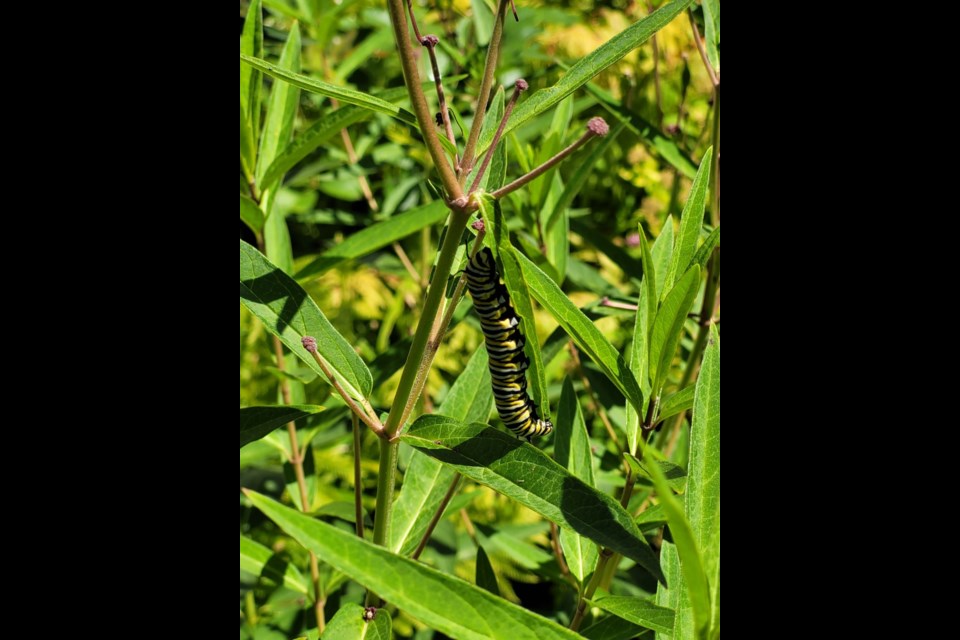While many of us are concerned about the survival of monarch butterflies, a few may be surprised to learn that Saskatchewan is not part of their preferred breeding range. In Canada, they most often breed in 小蓝视频ern and Central Ontario, followed by Quebec. Manitoba is listed as uncommon and Saskatchewan as sparse. (1996 data). Nevertheless, it is a real thrill to see their larvae chomping on your milkweed and pretty amazing to see adults take off from your yard.
There are about 100 milkweed varieties in North America of which 14 are native to Canada. A study in Iowa found that among the nine local milkweeds observed, the female monarchs most often laid their eggs on common milkweed (Asclepias syriaca) and swamp milkweed (Asclepias incarnata), both species common in Canada. It was also noted that depending on the season or growing conditions, all other species were also frequented.
Even though the range of bloom times cited for most milkweeds is May to September, in Saskatchewan milkweeds typically bloom later, from late June until early September. I have adjusted the heights of the plants to those typically observed here. So, let's have a look at the five milkweeds native to our province.
Whorled milkweed (Asclepias verticillata) should probably be avoided near pets and kids because of its toxicity. Its grass-like leaves blend in with grasses. It grows best in dry soils of various types, but will also thrive in average moist garden soil. Besides the monarch, it is also attractive to other pollinators. Typically between 20 cm to 50 cm high depending on growing conditions, the blooms are flat-topped clusters of greenish white flowers.
Green milkweed (Asclepias viridiflora), also known as green comet milkweed, has opposite leaves that are waxy to the touch. Their shape varies depending on growing conditions. The top leaves often cup around the greenish-yellow flower cluster. It usually sends up three stalks from the growing point, some of which may be recumbent, reducing its showiness as a landscape plant. Found in Saskatchewan in the Qu'Appelle Valley on hillsides, it does not thrive in disturbed areas. A more solitary plant, it does not form colonies. Plant it in full sun or partial shade.
Dwarf milkweed (Asclepias ovalifolia), also known as oval-leaved milkweed, as its name suggests, is shorter than other milkweeds, probably around 24 cm to 50 cm. It has oval-shaped, opposite leaves that are a little broader at the base and narrow to the tip. With an upright habit, the flowers are fragrant, white to pale green with pinkish overtones. It likes dry conditions in full sun to partial shade.
Common milkweed (Asclepias syriaca), is native to eastern Saskatchewan but colonizes readily in areas disturbed by agriculture. It can reach heights from 1 to 2.5 m in garden settings. Very aggressive, a neighbour had it for several years and it seemed well-behaved, but after the third year it became quite difficult to keep contained and this year has been “permanently controlled”. The leaves are broad, oblong to elliptical-shaped, thick and darker on top than their underside. They are opposite and in pairs. The flowers are spherical umbels, not particularly showy, ranging from pale pink to violet.
Showy milkweed (Asclepias speciosa) is said to be less aggressive than common milkweed. Very drought tolerant, it does well in a wide range of soils. Up to 90 cm tall, it has pompom clusters of white-pinkish star-shaped flowers.
Swamp milkweed (Asclepias incarnata), native to Manitoba, is the least poisonous and least aggressive of the species and is sold in the nursery trade as a garden plant. 'Ice Ballet' is a white selection while ‘Cinderella’ sports large clusters of rose-pink flowers. "Cinderella' late to emerge in spring, has done extremely well in my garden, and does not seem to be spreading. Clumps are 1 to 1.5m tall and enlarge a little each year. I remove the seedpods before they open and have a mulched garden. The long narrow leaves are opposite and in pairs. In full sun, they do well under normal garden conditions.
This column is provided courtesy of the Saskatchewan Perennial Society (SPS; [email protected]). Check our website () or Facebook page () for a list of upcoming gardening events.




